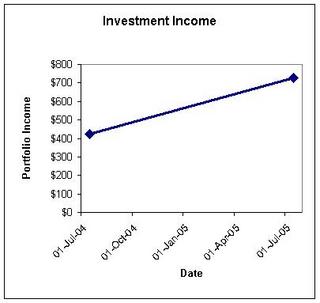As I drive towards my goal of an investment portfolio worth $300,000, I always keep the income that it is throwing off in the back of my mind. It is this income that is going to provide me with a good portion of my investing return over the years. I have started to use an Excel chart that graphically reminds me of this growing income stream. I find this is an awesome motivator to keep on course as it highlights progress towards my goal.
 REMEMBER though, as Canadian Capitalist pointed out in his blog, investing in dividend paying stocks requires you to complete your due diligence. Do not just invest in a stock because it provides you with a huge dividend. A poorly managed company can drop like a rock, and with it so can its dividend, a la Nortel. Dividends don't mean much then. You must understand what you are buying and feel comfortable that earnings will continue to rise in the future, and that you are getting in at a price you are comfortable. That is a judgment call. But more on that later...
REMEMBER though, as Canadian Capitalist pointed out in his blog, investing in dividend paying stocks requires you to complete your due diligence. Do not just invest in a stock because it provides you with a huge dividend. A poorly managed company can drop like a rock, and with it so can its dividend, a la Nortel. Dividends don't mean much then. You must understand what you are buying and feel comfortable that earnings will continue to rise in the future, and that you are getting in at a price you are comfortable. That is a judgment call. But more on that later...
Transactions for the week:
Stock: BCE Inc. Transaction: Dividend Reinvestment Amount: $18.60
Good Book: This is one of my favorite investing books of all time. I didn't list it in my Recommenced Reading post, but I should have.












